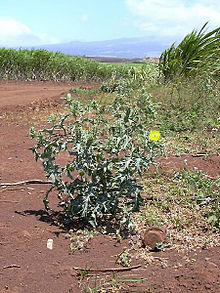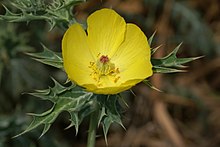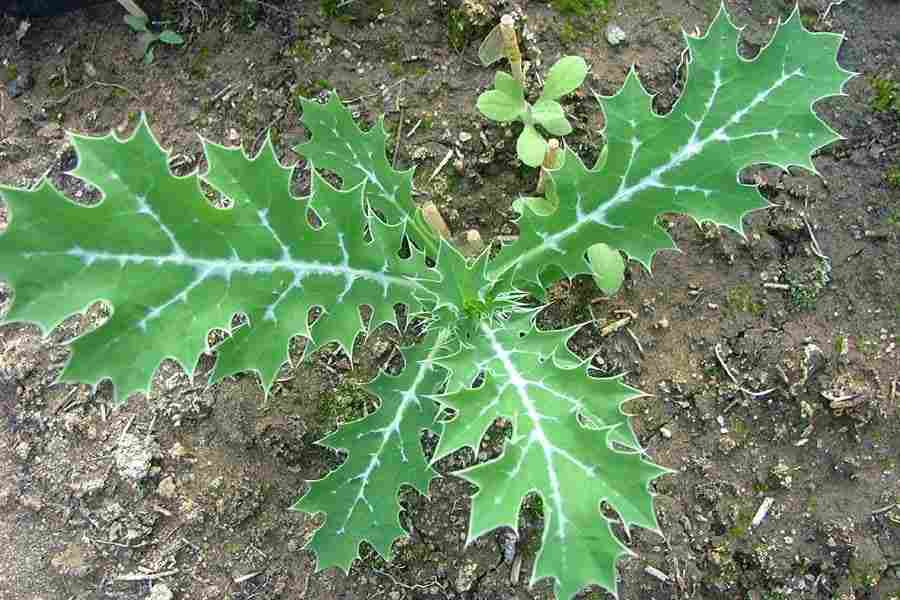Argemone Mexicana L.
| Botanical Name | Argemone Mexicana L. |
| Order: | Ranunculales |
| Family: | Papaveraceae |
| Genus: | Argemone |
| Species: | A. mexicana |
| Common Names: | Mexican Poppy, Prickly Poppy, Mexican Prickly, Yellow Poppy, Yellow Thistle, Mexican Thistle (English). Pivot Epineux, Pivot du Maxique, Tache De I’cell. Chardon du Pays (French). |
Plant Synonyms
Argemone ochroleuca sweet
Plant Local Names
Ghana: Akan-akusiribia, Twi-koksakyi aduro
Mali: Bambara – bozobo, Dogon –aignatawa Sonkerial, Senouto –naka- taba
Senegal: Wolof-garba-mag, Diola- fambora, Serer-dahatu
Togo: Adjaa-houetchegnon
Plant Habitat
Argemone Mexicana is native to Mexico but is now found in many tropical countries of both hemispheres. The plant is widespread throughout Africa and occurs irregularly in the Sudano-Sahelian zone of West Africa.
Plant Material of Interest
Aerial parts without seeds, leaf, Root
Plant Description
A mexicone is a branched and erect annual herb, reaching 1 m in height, with a woody base, leaves are alternate and sessile, glabrous lanceolate with lobed and serrated edge, teeth are tripped with pickly spikes, ribs are alternate, thorns on the lower limB; flowers are terminal and can reach 2.5 to 5 cm in diameter with green sapals and bright yellow petals; fruits are ovoid or spreading; latex is yellow white the seed is dark brown, round and clear.
Plant Used Parts
Plant Uses
The leaves are traditionally used in entheralgia. Muscle pain, gonorrhoea, constipation, jaundice and liver malfunction, uncomplicated malaria, cough toothache, yee pain, urthral discharge hepatobiliary disorders, bilious, fevers, enzema, and haematuria. The juice is used as a sedative and antiemtic, and in the treatment of ear infections and eye diseases. Infused seeds as well as the aerial part are used as diretic. Purgative and diaphloretic. The oil is used in constipation, insomnia, skin infections and sores.
Plant Therapeutic Action
Hypotensive, narcotic, diaphoretic, diuretic, antibacterial, antiviral, vulnerary laxative, antibacterial antiviral vulnerary laxative antinflammatory, antitussive, antifeedant and repellent (Sangare, 2003, Diallo et al., 2007; Adjobbiney et al., 2004. Bhatacharjee et al., 2006; Elango et al., 2011).
Plant Precaution for Use
Do not use beyond one week
Plant Adverse Effect
Vomiting, diarrhoea, sswollen legs, rash, shortness of breath and in extreme cases glaucoma, and cardial arrest.
Plant Contraindication
Children and pregnant women
Plant Dosage Forms
Decoction
Leaf powder: 30g in 500 ml of water for 30 min. Taken twice a day
Plant Dosage
Plant Storage
Store in a cool dry place away from light
Plant Chromatographic Fingerprint
Analytical TLC on solica gel G60 F254, 0.25 mm layer in petroleum ether (40-60)? Cy/chloroform [2:8] detection in daylight after spraying with anisaidehde (0.5 ml) mixed with 10 ml glacial acetic acid, 85 ml methanol and 5 ml concentrated sulphuric acid and heated to 100-110C? for 5-10 min. presence of four characteristics spots with R,s 0.63 (ash), 0.50 (pink).0.41 (pink) and 0.23 (violet).
Plant Constituents
Tennins, benzonquinones, coumarins, mucilage, sterols, triterpenes, and alkaloids (berberine; protopine, allocryptopina, benzophenanthridine, dihydrosangguinarine dihydrochelerithrine and chelerythrine); fat (cenryl alcohol, beta sitosterol), organic acid). Combined and free amino acids. Monosaccharides (glucose and fructose) and minerals, and vitamin C; flavonoids (rutin and quercetin) (Singh et al. 2011; Rahman and llyas. 1961).
Plant Pictures
Plant References
Adjobimey. T., Edaye, I., Lagnika, L., Gbenou, J. et al. (2004). Activitee antiplasmodiales in vitro de quelques plantes antipaukdiques de la pharmacopee beninoise, Comptes Randus Chimie 7: 1023-1027.
Bhattachacrjeee, I., Chatterjee, S.K., Chaterjee, S., Chandra, G. (2006). Antibacterial potentiality of Argenone Mexicana solvet extracts against some pathogenic bacteria. Memorias do Instituto Oswaldo Cruz 101 (6):645-648.
Dakuo, F. (2008). Etude comparative du treatment du paludisme simple presomptif a domicile per A. Mexicana et les combinaisons therapeutiques a base d’arteminshinine dans le village du Missidougou Region de Sikasso. These de medecine Bamako, 94p.
Daillo, D., Graz, B., Falquet, J., Traore, A.K. et al. (2006). Malaria treatment in remote areas of Mali: use of modern and traditional medicines, patient outcome. Transaction of the Royal Society of Tropical Medicine and Hygiene 100:515-520.
Elsngo, G., Rehuman, A.A., Kamaraj, C., Bagavan, A., Zair, A.A. (2011). Screening for feeding different activity og herbal extracts against the lesves of malaria vector Anopheles subpictus Grassi. Parasitology Research 108 (3):513-519.
Graz, B., Willcox, M.L., Diakite, C., falquet., J. et al. (2010) argemone Mexicana decoction versus artesunate-amodiaquine for the management of malaria in Mali policy and public-health implications. Transactions of Royal Society of Tropical Medicine and hygiene. 104(1):33-41.



